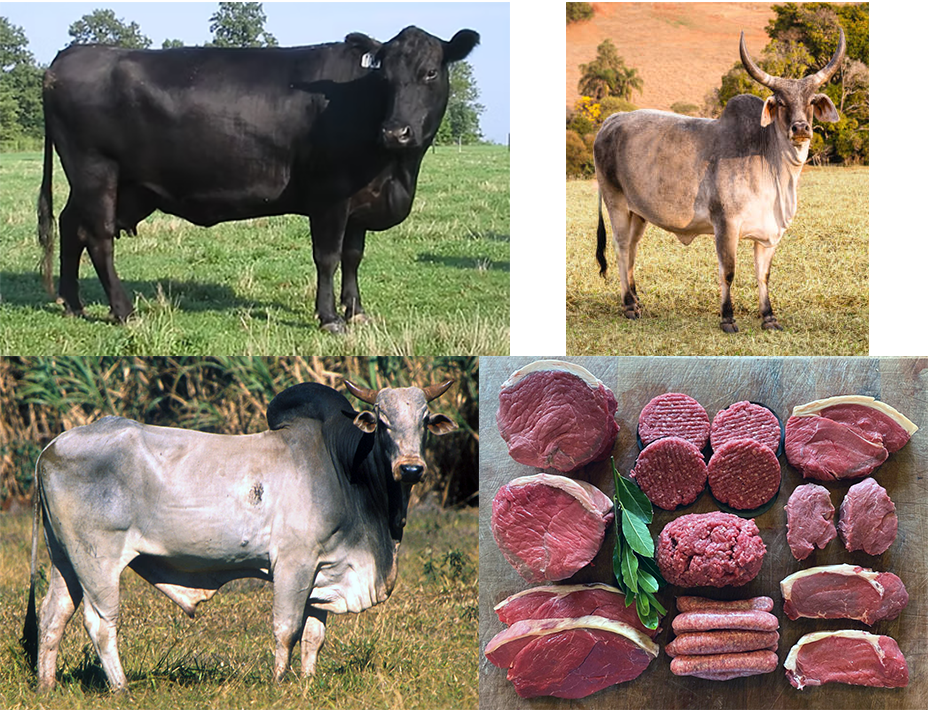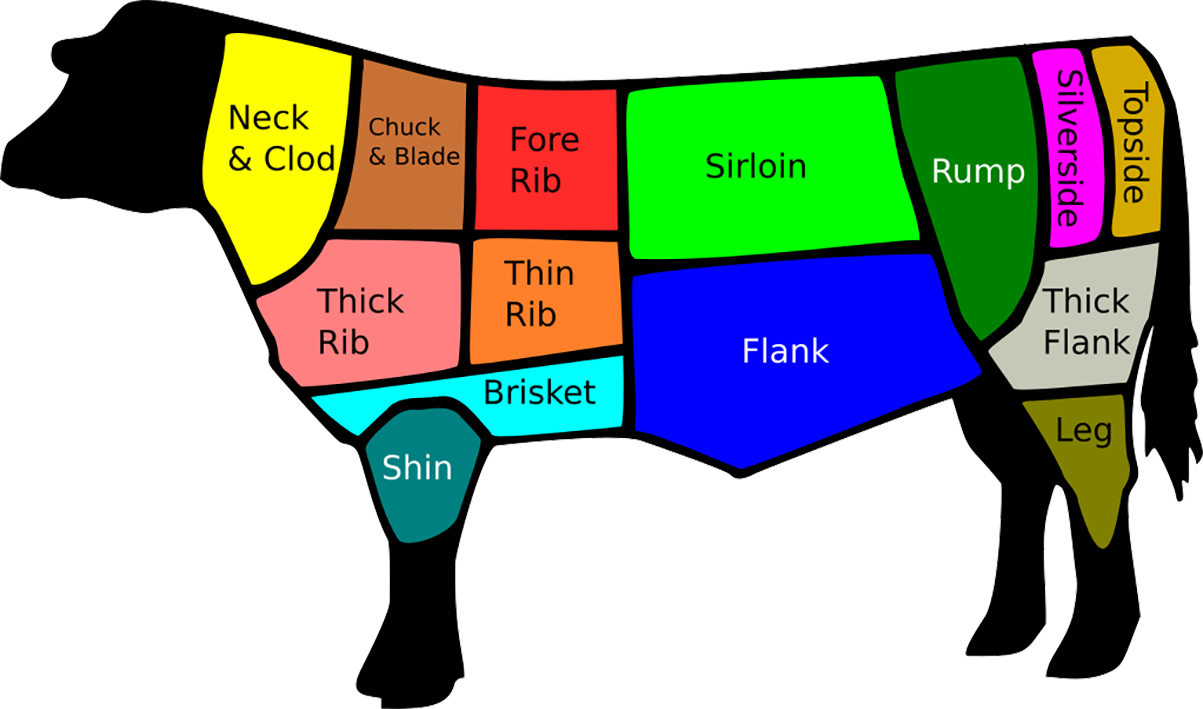FabulousFusionFood's Beef-based Recipes 5th Page
 Image of an European cow (top left), African Zebu (top right) and
Image of an European cow (top left), African Zebu (top right) andIndian bull (bottom left) along with a selection of beef cuts.
Welcome to FabulousFusionFood's Beef-based Recipes Page — The recipes presented here are all based on cow meat. Beef is the culinary name for meat from cattle (Bos taurus or Bos indicus). Beef can be prepared in various ways; cuts are often used for steak, which can be cooked to varying degrees of doneness, while trimmings are often ground or minced, as found in most hamburgers. Beef contains protein, iron, and vitamin B12. Along with other kinds of red meat, high consumption is associated with an increased risk of colorectal cancer and coronary heart disease, especially when processed. Beef has a high environmental impact, being a primary driver of deforestation with the highest greenhouse gas emissions of any agricultural product.
People have eaten the flesh of bovines since prehistoric times; some of the earliest known cave paintings, such as those of Lascaux, show aurochs in hunting scenes.[6] People domesticated cattle to provide ready access to beef, milk, and leather.[7] Cattle have been domesticated at least twice over the course of evolutionary history. The first domestication event occurred around 10,500 years ago with the evolution of Bos taurus. The second was more recent, around 7,000 years ago, with the evolution of Bos indicus in the Indian subcontinent. There is a possible third domestication event 8,500 years ago, with a potential third species Bos africanus arising in Africa.
Most beef can be used as is by merely cutting into certain parts, such as roasts, short ribs or steak (filet mignon, sirloin steak, rump steak, rib steak, rib eye steak, hanger steak, etc.), while other cuts are processed (corned beef or beef jerky). Trimmings, on the other hand, which are usually mixed with meat from older, leaner (therefore tougher) cattle, are ground, minced or used in sausages. The blood is used in some varieties called blood sausage. Other parts that are eaten include other muscles and offal, such as the oxtail, liver, tongue, tripe from the reticulum or rumen, glands (particularly the pancreas and thymus, referred to as sweetbread), the heart, the brain (although forbidden where there is a danger of bovine spongiform encephalopathy, BSE, commonly referred to as mad cow disease), the kidneys, and the tender testicles of the bull (known in the United States as calf fries, prairie oysters, or Rocky Mountain oysters). Some intestines are cooked and eaten as is,[64] but are more often cleaned and used as natural sausage casings. The bones are used for making beef stock. Meat from younger cows (calves) is called veal. Beef from steers and heifers is similar.
he word beef is from the Latin word bōs, in contrast to cow which is from Middle English cou (both words have the same Indo-European root *gʷou-). This is one example of the common English dichotomy between the words for animals (with largely Germanic origins) and their meat (with Romanic origins) that is also found in such English word-pairs as pig/pork, deer/venison, sheep/mutton, and chicken/poultry (also the less common goat/chevon). Beef is cognate with bovine through the Late Latin bovīnus.[4] The rarely used plural form of beef is beeves.
Cuts of Beef (British, Irish,Australian, South African and New Zealand terms):
 Cuts of Beef:
Cuts of Beef:Tongue — boiling, pickling, roasting or braising
Necks and clod — stewing, slow smoking or braising
Chuck steak & blades — mincing, braising, slow roasting
Sirloin — Frying, roasting, barbecuing
Rump — Frying, barbecuing
Silverside — Roasting
Topside — Roasting, pies, air drying
Top rump — Roasting, barbecuing
Fore rib — Roasting
Rib eye steak — Frying
T-bone steak — Frying
Thick rib — Braising, barbecuing, roasting
Thin rib — Braising, barbecuing
Brisket (Skirt steak) — Baking, boiling, roasting, braising
Shin and leg — Mince, slow stewing, braising
Flank — Barbecued, grilled, braised
Thick flank — Barbecued, grilled, braised
Feather blade — Frying, braising
Fillet — Frying, tartare
Oxtail — Stew, braising
Offal — typically liver, heart, stomach, intestines and kidneys
The alphabetical list of all the beef-based recipes on this site follows, (limited to 100 recipes per page). There are 697 recipes in total:
Page 5 of 7
| Minchet Abish Wot Origin: Ethiopia | Nyma Choma (Roast Meat) Origin: East Africa | Pasties Boiled in Beef Broth Origin: Cornwall |
| Minestra siciliana di Pasqua (Sicilian Easter Soup) Origin: Italy | Obe Ata (Nigerian Pepper Soup) Origin: Nigeria | Patina Cotidiana (Everyday Dish) Origin: Roman |
| Minutal Terentinum (Terentine Ragout) Origin: Roman | Oenogarum cum Thymum et Satureiam in Tubera (Truffles in Savory-thyme Wine Sauce) Origin: Roman | Patina Fusilis (A Fluid Dish) Origin: Roman |
| Mititei (Romanian Minced Meat Sausages) Origin: Romania | Oenogarum et Coriandrum in Tubera (Truffles in Coriander Wine Sauce) Origin: Roman | Patinam ex Lacte (Milk Casserole) Origin: Roman |
| Miyan Kuka II (Baobab Leaf Soup II) Origin: Nigeria | Ofellas Ostienses (Ostian-style Starters) Origin: Roman | Peanut Soup Origin: West Africa |
| Mogatla (Oxtail Casserole) Origin: Botswana | Ojojo Meat Balls Origin: Nigeria | Pelau Origin: Saint Kitts |
| Mologothannie Origin: Sri Lanka | Olusatra (Alexanders with Raisin Sauce) Origin: Roman | Pelmeni (Siberian Beef Dumplings) Origin: Siberia |
| Monkey Gland Steak Origin: Southern Africa | Oluwombo Origin: Uganda | Pepperpot Origin: Antigua |
| Mooli and Garlic Beef with Pine Nuts Origin: Australia | Onion Gravy Origin: Britain | Pety parnant (Small Patties) Origin: England |
| Moretariaum (Country Sauce) Origin: Roman | Onions Stuffed with Meat and Mushrooms Origin: Czech | Pho Bo Noodle Soup (Pho Bo Soup) Origin: Vietnam |
| Moussaka Origin: Greece | Oodkac (Somali Preserved Meat) Origin: Somalia | Picadillo Origin: Cuba |
| Mrs Beeton Herodotus Pudding Origin: Britain | Or Lam Origin: Laos | Pieds de zébu et haricots blancse (Zebu Feet with White Beans) Origin: Madagascar |
| Mshakiki (Comorian Kebabs) Origin: Comoros | Osso Bucco alla Milanese Origin: Italy | Pigeon Peas and Rice Origin: Barbados |
| Mtsolola à la viande (Bananas and Meat) Origin: Mayotte | Ox-heart Black Curry Origin: Sri Lanka | Pigeon Pie Origin: British |
| Mughlai Beef Biriani Origin: India | Ox-heart Haggis Origin: Scotland | Pilau Boeuf de Comores (Comorian Beef Pilau) Origin: Comoros |
| Muhogo ya andzi Na nyama (Cassava with Meat) Origin: Mayotte | Oxford Sausages Origin: England | Piroshki Origin: Russia |
| Mullah Bamyah (Beef and Okra Stew) Origin: Sudan | Oxtail Pot Pies Origin: South Africa | Pisam Adulteram Versatilem (Peas Turnover) Origin: Roman |
| Mulligatawny Soup Origin: Anglo-Indian | Pabellón Criollo (Venezuelan Shredded Beef with Rice and Beans) Origin: Venezuela | Plat Tradicional Fula (Traditional Fulani Dish) Origin: Guinea-Bissau |
| Muqmad (Djibouti Preserved Meat) Origin: Djibouti | Packet and Tripe Origin: Ireland | Plo Origin: St Helena |
| Mustard Beef with Potato Gratin Origin: Australia | Pad Gra Prow (Holy Basil Beef) Origin: Thailand | Podin Henlys (Helston Pudding) Origin: England |
| Musti Suktinukai (Lithuanian Beef Rolls) Origin: Lithuania | Pakistani Seekh Kebab Origin: Pakistan | Portable Soup Origin: Britain |
| My Lady of Portlandàs Mince Pyes Origin: Britain | Pan Haggis Origin: Scotland | Pot au Feau Origin: France |
| Naga Curry Origin: Fusion | Pappardelle with Slow-cooked Beef and Mushrooms Origin: Britain | Pot au Feu Origin: France |
| Nandji de Boeuf (Nandji of Beef) Origin: Cote dIvoire | Pastai Briwgig Eidion a Nionod (Welsh Beef Mince and Onion Pies) Origin: Welsh | Potage au Vermicelle (Vermicelli Soup) Origin: Britain |
| Nasi Beriani (Malaysian Beriani) Origin: Malaysia | Pastai Cig Llo (Veal Pie) Origin: Welsh | Potes Cig Eidion (Beef Pottage) Origin: Welsh |
| Ndizi na Nyama (Plantains with Meat) Origin: East Africa | Pastai Cwnhingen (Rabbit Pie) Origin: Welsh | Potes Cig Eidion II (Welsh Beef Stew II) Origin: Welsh |
| Ndolé à la Viande (Bitterleaf with Meat) Origin: Cameroon | Pastai Nadolig Eidion a Chlementin (Christmas Beef and Clementine Pie) Origin: Welsh | Potjeikos Origin: Southern Africa |
| New noumbles of dere (Fresh Deer Offal) Origin: England | Pastechi Karni (Aruban Meat Empanadas) Origin: Aruba | Potted Beef Origin: British |
| New Zealand Beef Curry Origin: New Zealand | Pastei Arennau ac Eidion (Steak and Kidney Pie) Origin: Welsh | Potted Hough Origin: Scotland |
| Nigerian Fried Rice II Origin: Nigeria | Pastelón (Sweet Plantain Lasagna) Origin: Puerto Rico | Potted Ox Cheek Origin: Scotland |
| Nuernberger Rostbratwuerste (Nuremberg Grilled Sausage) Origin: Germany | Pastelón de Arroz (Cheesy Beef and Rice Casserole) Origin: Dominican Republic | Pressure Cooker Beef and Stout Stew Origin: Ireland |
| Nyama na Irio (Meat with Corn) Origin: Kenya | Pastelón de Harina de Maíz (Cornmeal and Beef Casserole) Origin: Dominican Republic | Pressure Cooker Beef in Pepper Sauce Origin: American |
| Nyama ya Figo (Beef and Kidneys) Origin: Tanzania | Pastelón de Papa (Dominican Cottage Pie) Origin: Dominican Republic | |
| Nyeleng (Beef and Peanut Gumbo) Origin: Senegal | Pašticada (Dalmatian Beef Stew with Prunes and Apples) Origin: Croatia |
Page 5 of 7